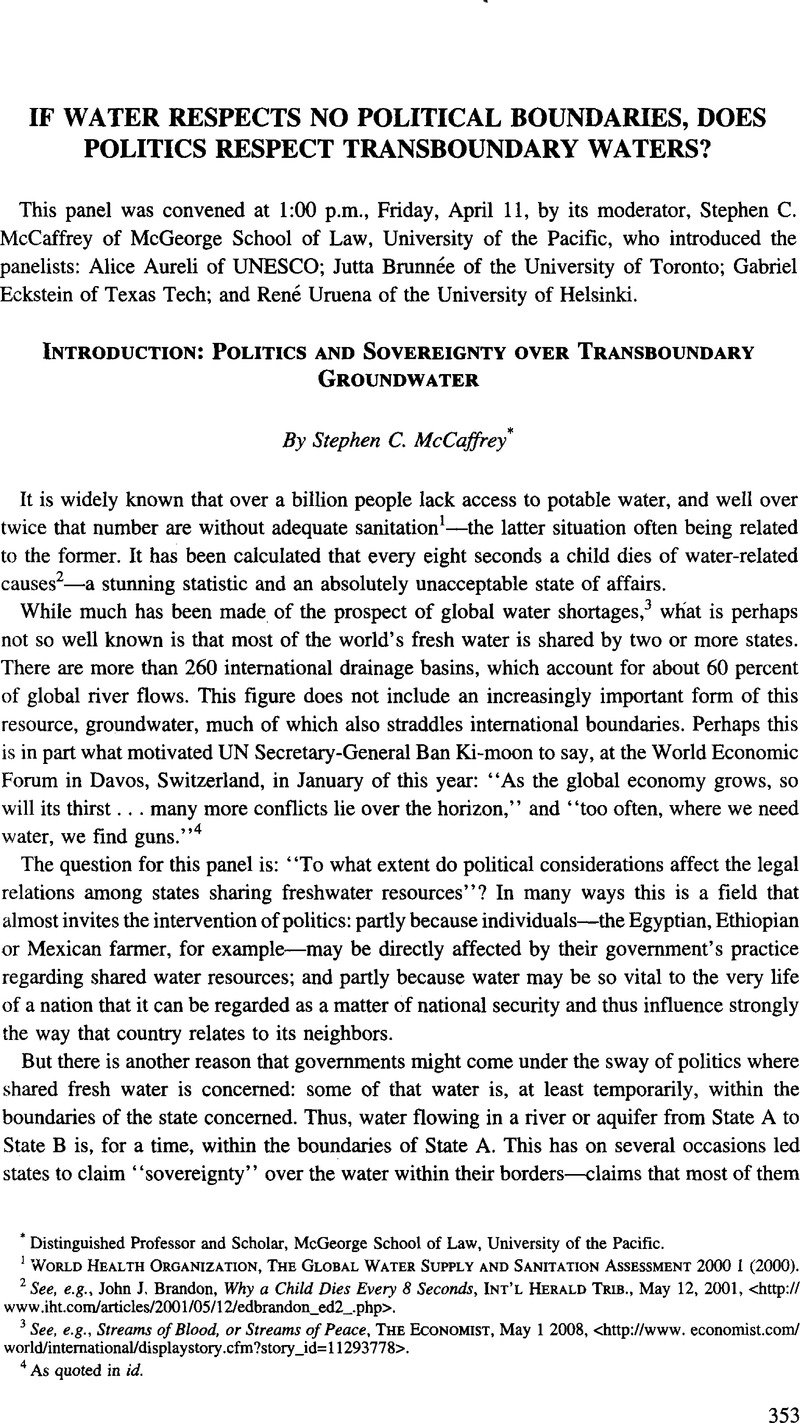Article contents
Introduction: Politics and Sovereignty over Transboundary Groundwater
Published online by Cambridge University Press: 28 February 2017
Abstract

- Type
- If Water Respects No Political Boundaries, Does Politics Respect Transboundary Waters?
- Information
- Copyright
- Copyright © American Society of International Law 2008
References
1 World Health Organization, The Global Water Supply and Sanitation Assessment 2000 1 (2000).
2 See, e.g., John J, Brandon, Why a Child Dies Every 8 Seconds, Int’l Herald Trib., May 12, 2001, <http://www.iht.com/articles/2001/05/12/edbrandon_ed2_.php.>
3 See, e.g., Streams of Blood, or Streams of Peace, The Economist, May 1 2008, <http://www.economist.com/world/international/displaystory.cfm?story_id=11293778>.
4 As quoted in id.
5 This is true, most infamously, of the “Harmon Doctrine” of absolute sovereignty, stated by U.S. Attorney General Judson Harmon in the context of a dispute with Mexico over the Rio Grande. 21 Op. Att’y Gen. 281 (1898). The dispute was settled in a 1906 treaty entitled Convention concerning the Equitable Distribution of the Waters of the Rio Grande for Irrigation Purposes, 21 May 1906, T.S. No. 455, and the United States later expressly repudiated the Harmon Doctrine. See generally Mccaffrey, Stephen C., The Law of International Watercourses 76-110 (2nd ed. 2007)Google Scholar.
6 For discussion of the “absolute territorial sovereignty” and “absolute territorial integrity” theories, on occasion advocated by upstream and downstream states, respectively, see Mccaffrey, id., at 112-135.
7 U.N. Doc. A/RES/51/869 (May 21, 1997), 36 I.L.M. 700 (1997).
8 Case Concerning the Gabčíkovo-Nagymaros Project (Hungary/Slovakia), 1997 I.C.J. 7, at 54 (Sept. 25).
9 2006 ILC Report 185, available on the ILC’s website, <http://www.un.org/law/ilc/>.
10 Id. at 202.
11 None of the authorities cited by the Commission in its commentary to art. 3 deals with transboundary ground-water, or otherwise recognizes “sovereignty” over shared freshwater resources. Id. at 202-203, notes 491-493.
12 See Draft articles on the Law of the Non-Navigational Uses of International Watercourses, 1994 Y.B. ILC, v. 2, pt. 2, p. 89; The International Law Association’s “Seoul Rules,” The Law of International Groundwater Resources, Ila, Report of the Sixty-second Conference, Seoul 1986, pp. 21 and 231-285 (1986); and the highly regarded Bellagio Draft Agreement concerning the Use of Transboundary Groundwaters, contained in Hayton, Robert D. & Utton, Albert E. Transboundary Groundwaters: The Bellagio Draft Treaty, 29 Nat. Res. J. 663, 676 (1989)Google Scholar.
13 Art. 2(a), 2006 ILC Report, supra note 8, at 198.
14 U.N. Convention, supra note 6, art. 2(a).
15 2006 ILC Report, supra note 8, at 202, para. 1 of commentary to art. 3.
16 Shared natural resources: comments and observations by Governments on the draft articles on the law of transboundary aquifers, U.N. Doc. A/CN.4/595, available at <http://daccessdds.un.org/doc/Undoc/Gen/N08/284/80/Pdf/N0828480.pdf?OpenElement>.
17 Id. at 22.
18 See Mccaffrey, supra note 5, at 500-502; and McCaffrey, Stephen C, ‘Comments on the International Law Commission’s Draft Articles on the Law of Transboundary Aquifers (2006)’ (Mar. 30, 2008), available at SSRN: <http://ssrn.com/abstract=l114988>.
- 1
- Cited by


